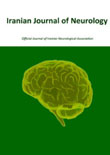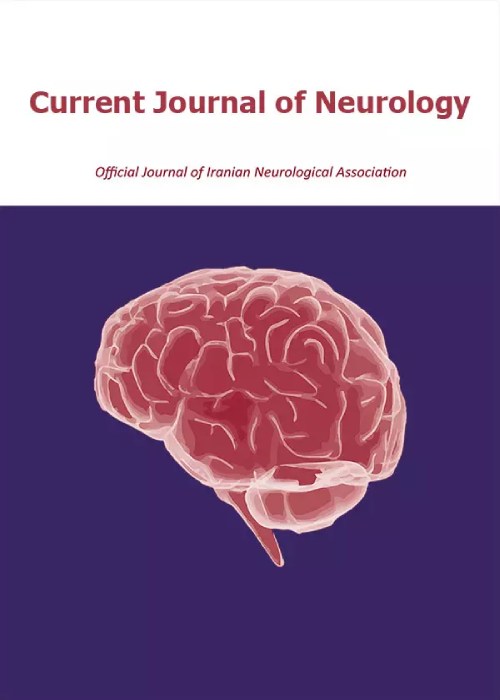فهرست مطالب

Current Journal of Neurology
Volume:14 Issue: 4, Autumn 2015
- تاریخ انتشار: 1394/08/21
- تعداد عناوین: 10
-
-
Pages 185-189BackgroundIntracranial lesions of the pituitary gland are common pituitary adenomas, accounting for 6-10% of all symptomatic intracranial tumors. In this retrospective study, the clinicopathologic features and survival rate of pituitary adenomas were evaluated.MethodsThe present retrospective study was conducted on 83 patients with pituitary adenomas, referring to radiation oncology departments of Ghaem and Omid Hospitals, Mashhad, Iran, over a period of 13 years (1999-2012). Data obtained from clinical records including clinical features, type of surgery (if performed), treatment modality, overall survival rate, and progression-free survival rate were analyzed.ResultsEighty-three patients including 44 males (53%) and 39 females (47%) participated in this study. The median age was 40 years (age range: 10-69 years). Chiasm compression was reported in 62 patients (74.4%), and 45.78% of the subjects suffered from headaches. Functional and non-functional adenomas were reported in 44 (53.01%) and 39 (46.99%) patients, respectively. In cases with functional and non-functional adenomas, the disease was controlled in 95 and 84.5% of the subjects for 3 years, respectively. Furthermore, 1- and 3-year survival rates for functional adenoma were 84.6 and 23%, respectively; the corresponding values were 90.9 and 22.7% in non-functional adenomas, respectively.ConclusionIn this study, a significant correlation between headache severity and type of adenoma was observed. So, application of surgery and radiotherapy together could be a highly effective approach for treating functional adenomas, although it is less efficient for the non-functional type.Keywords: Pituitary Adenoma, Functional Adenoma, Survival Rate
-
Pages 190-194BackgroundNon-dystrophic myotonias are a heterogeneous set of skeletal, muscular channelopathies, which have been associated with point mutations within sodium channel α-subunit (SCN4A) gene. Because exons 22 and 24 of SCN4A gene are recognized as hot spots for this disease, the purpose of the study is to identify mutation in exons 22 and 24 of SCN4A gene in Iranian non-dystrophic myotonias patients.MethodsIn this study, 28 Iranian patients with non-dystrophic myotonia analyzed for the mutation scanning in exons 22 and 24 of SCN4A gene by polymerase chain reaction-single strand conformational polymorphism (PCR-SSCP) and sequencing.ResultsWe found 29073G>C substitution in SCN4A gene in one case and 31506A>G substitution in seven cases. The 29073G>C substitution causes a missense mutation G1306A, located in the conserved cytoplasmic loop connecting repeat III and IV of the SCN4A channel but, 31506A>G substitution do not alter amino acid in SCN4A protein.ConclusionG1306A residue is located in functionally important protein region. In “hinged-lid model” for Na+ channel inactivation in which glycines1306 act as the hinge of the lid occluding the channel pore. Mutation in this region slowed fast inactivation. Therefore, it might be a pathogenic mutation. The causal relationship of this mutation with the disease is an object for further discussion.Keywords: Nondystrophic Myotonia, Mutation, SCN4A, Polymerase Chain Reaction, Single Strand Conformational Polymorphism
-
Pages 195-203BackgroundParkinson’s disease (PD) is a common neurodegenerative disease resulting from the degeneration of dopaminergic (DA) neurons in the substantia nigra pars compacta (SNc). Increasing evidence demonstrated that mice treated intranasally with 1-methyl-4-phenyl-1,2,3,6-tetrahydropyridine (MPTP) suffered impairments in motor functions associated with disruption of DA neurons in SNc conceivably analogous to those observed in PD. L-arginine has been proposed as a novel neuroprotective agent that plays protective roles in several models of neuronal cellular damage. This study aimed to evaluate the effects of L-arginine on the numerical density of dark neurons (DNs) in the SNc of Balb/c mice subjected to MPTP administration.MethodsIn the present study, we demonstrated that repeated treatment with L-arginine (300 mg/kg, i.p.) during 7 consecutive days attenuated the production of DNs in SNc of adult male Balb/c mice infused with a single intranasal administration of MPTP (1 mg/nostril).ResultsPre-treatment with L-arginine significantly decreased the numerical density of DNs in SNc of mice 21 days after intranasal MPTP administration.ConclusionThis investigation provides new insights in experimental models of PD, indicating that L-arginine represents a potential neuroprotective agent for the prevention of DA neuron degeneration in SNc observed in PD patients.Keywords: Parkinson Disease_1_Methyl_4_phenyl_1_2_3_6_tetrahydropyridine_BALB C Mice_Protective Agents
-
Pages 204-210BackgroundNeuromyelitis optica (NMO) is an uncommon neuro-inflammatory syndrome that has shown to be distinct from multiple sclerosis (MS) and associated with the autoantibody marker NMO-immunoglobulin G (IgG). There are still only a few studies regarding the epidemiology of NMO in Iran. In the present study, we tried to describe the epidemiology of NMO in Khuzestan as one of the densely populated regions in Iran.MethodsA cross-sectional study was performed during the period 2013-2014. Multiple regional sources of data were used including hospital records, details from neurologists and MS society database. The diagnosis of NMO was based on clinical presentation, abnormal findings on neuroimaging and serological tests.ResultsA 51 Caucasian patients (36 patients with NMO and 15 with NMO-spectrum disorder) were identified with a female/male ratio of 7.5:1.0. The crude prevalence of NMO was 1.1/100,000 population. The mean age at onset was 29.2 ± 6.1 years and the mean duration of symptoms was 5.0 ± 0.4 years. The majority of patients (60.8%) were classified as having mild disability (Expanded Disability Status Scale = 0-3.5). Among of 35 patients whose titer of NMO-IgG was measured, 19 (54.2%) were seropositive.ConclusionOur study suggests that NMO prevalence rate in South West Iran (Khuzestan Province) is much lower than that reported for MS prevalence rate (16.2/100,000) and our patients had a lower age at onset presentation and milder course of the disease than western countries.Keywords: Neuromyelitis Optica, Multiple Sclerosis, Epidemiology, Prevalence, Iran
-
Pages 211-218BackgroundHealth workforce shortages in rural and remote areas are a global challenge that almost every health system has to deal with. This study aimed to discover neurosurgeons’ job preferences and propose policy interventions that could possibly increase their retention in rural, remote, or underserved areas.MethodsA discrete choice experiment (DCE) was conducted in November 2014 with a sample of Iranian neurosurgeons selected from five contrary’s provinces representing the geographical diversity. Job attributes included income, dual practice opportunities, workload, proximity to family, clinical infrastructure, housing, educational facilities, and work location. Probit regression model was used to estimate the importance of different job attributes and examine the extent to which neurosurgeons were willing to tradeoff between monetary and nonmonetary attributes.ResultsFindings indicated that increased salary, permission to undertake dual practice and access to adequate clinical infrastructure were the most important retention policies. Provision of subsidized housing and educational facilities also increased neurosurgeons’ attraction and retention in rural areas.ConclusionA range of policy interventions focusing on both monetary and nonmonetary incentives are required to increase neurosurgeons’ retention in rural, remote, or underserved areas.Keywords: Discrete Choice Experiment, Stated Preference, Health Manpower, Rural Areas
-
Pages 219-221


